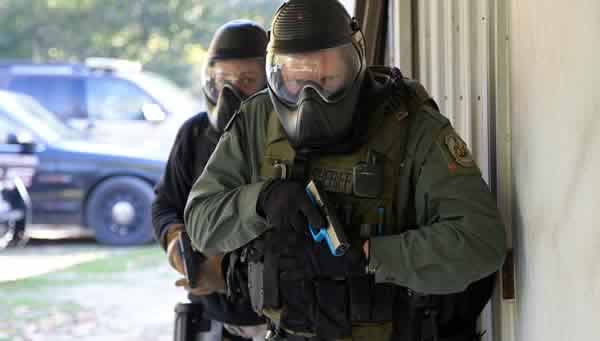
Fight your Way to your Gun
In a close quarters battle reaching for your gun may not be the best choice. Remember, the root word of gunfight is fight, not gun. From contact distance to about 3 feet, you can strike your adversary, hard, and use those blows to create distance and decide if you need to reach for your gun.

Using a Kubaton, marker, flashlight or other impact weapon to increase the power of your strike will provide maximum benefit to your aggressive actions. Remember, never just throw one strike. Attack in combination and keep moving to gain distance. The downside to this is that you will need to work on getting your non-dominant arm competent enough to fight.
Video Transcription
Hi I’m Kevin Michalowski, editor of Concealed Carry magazine. And you may not even get to access your firearm in an extremely close-quarters battle.
We don’t get the luxury of making sure that people stay 21 feet away from us at all times. In some cases, we end up very close together in a face-to-face confrontation. And at that point, the most interesting thing at the USCCA expo in Fort Worth, Tim Kennedy told me that at contact distance, if I tried to draw a gun, he would just beat me to death. And that got me to thinking.
At this distance, you may not be able to get to your firearm; in fact, it’s probably better if you don’t. You have to use combative techniques. That’s handfighting, or maybe an alternate weapon. This is a Sharkie. Yes, a sharkie. It’s an actual working marker made by the ColdSteel company, but it’s a glass-filled nylon tube that offers some extra strength, and really works basically as a kubaton. A short little baton to give you some added power in your strikes.
In a position like this, we don’t ever want to be directly head-on one-on-one face to face with a person. I wanna be moving off, at about a one-thirty position, or even further to the side, especially getting away from that right hand. If you think this guy’s going to punch you with a big overhand right, which is what most people who aren’t trained as fighters will do, that big roundhouse they’re going to swing at you.
In that case, at this distance, I’m not going to be reaching for my gun, that opens up my head to get punched in the side of the face. I want to deflect that incoming punch, get your hand up, block the punch, hold it up there long enough to make sure you’re not going to get hit in the head hard -you may get hit in the head, but not hard- and then drive your kubaton -your Sharkie- right down into the shoulder. Right between the collarbone right here. There’s a big pack of nerves right here in the shoulder. Drive that down in, and at the same time strike to the head. Immediately strike to the head. We don’t ever, when we’re in a combative situation, want to just use one blow and then wait and see what happens. We want a combination of blows.
So we drive it down into the collarbone, and then follow up with a strike to the face, and then you can step back and decide whether or not we want to use our firearm. Grabbing this sharkie or pen or kubaton or anything else out of your pocket is very unobtrusive. And if this person is approaching you and getting close, clearly can tell by voice inflection or something else that this is probably gonna be a bad situation, it might be time to prepare yourself for action. Pulling out a pen usually doesn’t mean anything. Now one of those tactical pens with the really sharp point on it might impale and stick into this person. In a deadly force situation that’s okay, but in what reasonable people might see as ‘just a regular fight’, you’ll want to use something that you’re really not going to stab this person with, it’s just adding an extra level to your strike. It focuses all your energy on this point, and you drive it into that band of nerves, just to get their attention. To stop their hostile activity. You may get what we call an immediate cessation of hostile activity instantly when you drive this pen down into that collarbone area. But still, follow up with that strike, and then step back. Remember, the goal of self-defense is to create enough dysfunction in your attacker to allow you to escape. In a close-quarters battle situation, you may not have to go to your firearm, you may only use comabative moves to get some distance and get away.
I’m Kevin Michalowski, Editor of Concealed Carry Magazine. If you like these videos, please share them with all your friends and subscribe to our page. I’ll give you more great information every week.
Sources: USCCA Youtube, Kevin Michalowski



